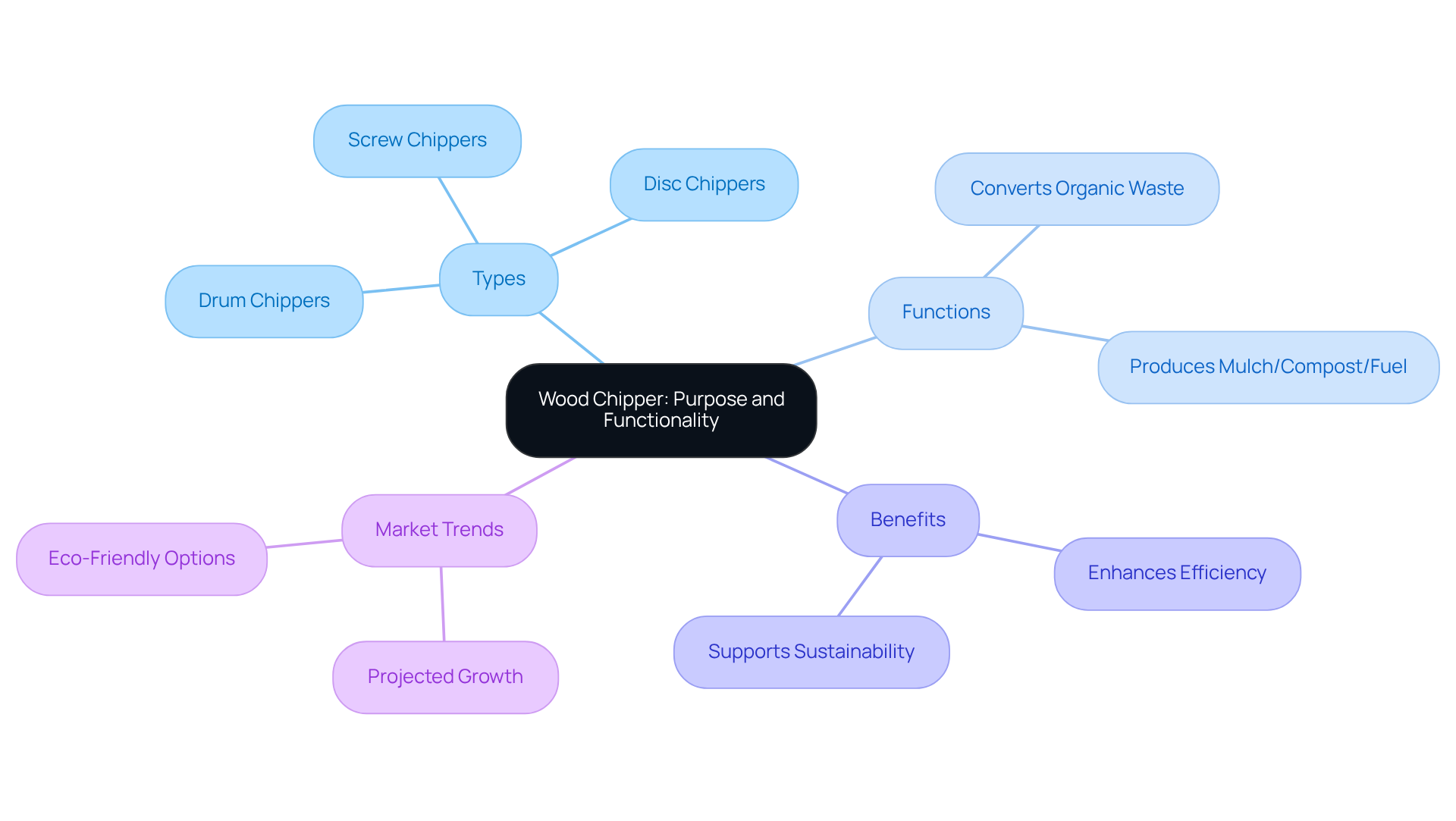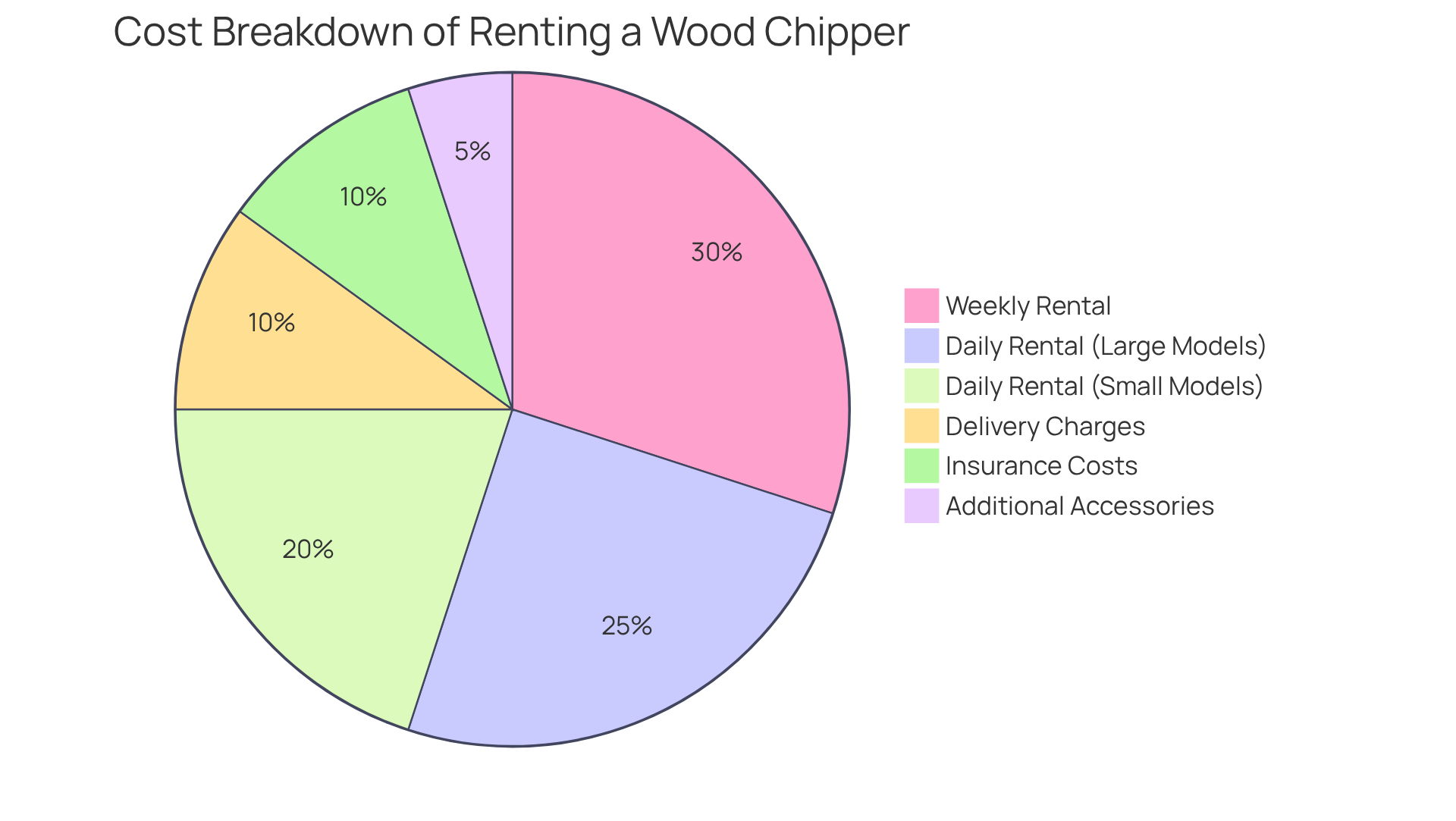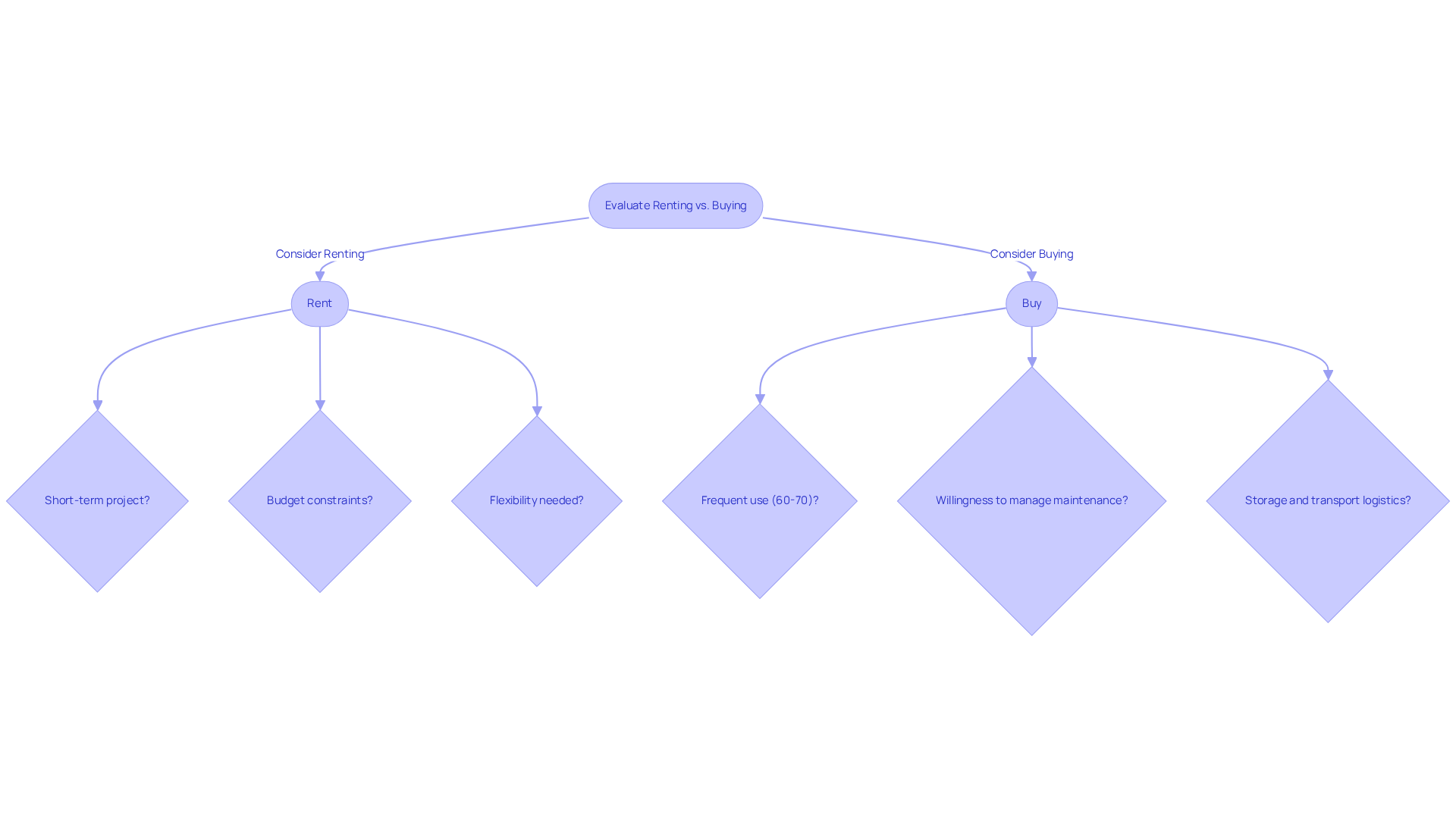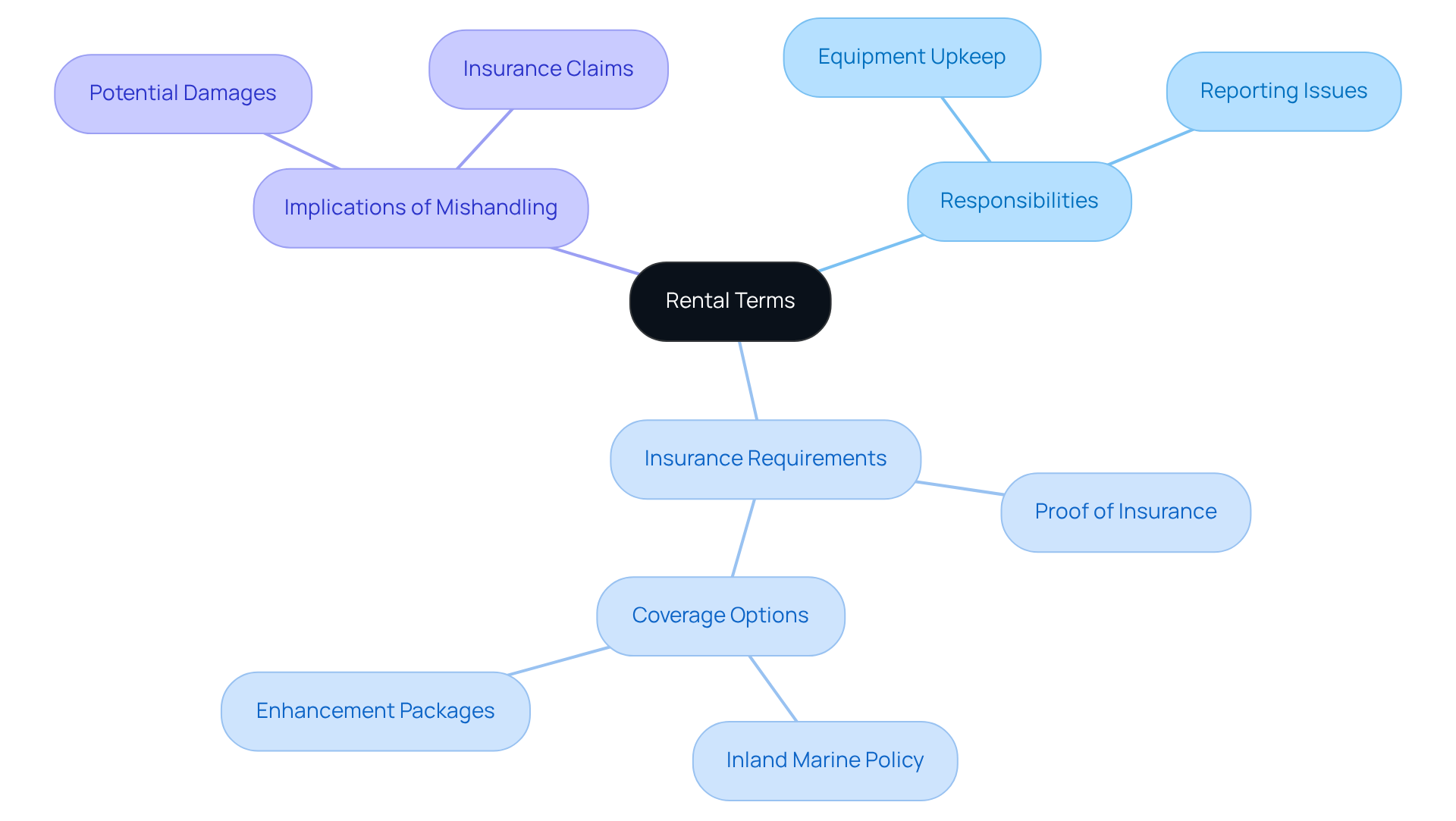Overview
Renting a wood chipper can vary significantly in cost, influenced by several factors including:
- Machine size
- Type
- Rental duration
- Additional expenses such as delivery and insurance
Daily rental rates typically range from $70 to $500. Understanding this pricing structure is crucial for effective budgeting. Renting is often a more economical choice for temporary needs compared to purchasing, making it a smart decision for those who require equipment for a limited time. By considering these factors, customers can make informed choices that align with their project requirements.
Key Highlights:
- Wood chippers, also known as timber shredders, convert large branches and tree limbs into smaller pieces for effective waste management.
- They are used in landscaping and forestry, with chips repurposed for mulch, compost, or biomass fuel.
- Types of wood chippers include drum chippers, disc chippers, and screw chippers, available in various sizes.
- Rental costs for small wood chippers range from $70 to $150 per day, while larger models can cost between $200 and $500.
- Additional costs may include delivery charges (typically $50 to $150) and insurance (approximately 15% of the rental price).
- The timber shredder leasing market is projected to grow from $291.2 million in 2022 to $420.6 million by 2033.
- Renting is often more cost-effective for temporary needs, while purchasing may be better for frequent use, especially if used 60-70% of the time.
- Renters must understand their responsibilities, including maintenance and insurance requirements, to avoid unexpected costs.
Introduction
Understanding the intricacies of renting a wood chipper is essential for anyone aiming to manage yard waste or undertake landscaping projects efficiently. With the rising demand for eco-friendly solutions and effective waste management, the cost to rent these powerful machines can vary significantly based on several factors, including:
- Size
- Type
- Rental duration
However, the decision to rent or buy a wood chipper poses a critical question: is it more economical to lease this equipment for occasional use, or does ownership offer long-term benefits that outweigh the costs? Exploring these dynamics can lead to smarter choices and substantial savings for both homeowners and professionals alike.
Define Wood Chipper: Purpose and Functionality
A timber shredder, often referred to as a tree shredder, is an essential machine designed to convert large branches and tree limbs into smaller pieces of timber. This equipment is vital in landscaping, forestry, and waste management, enabling the efficient disposal of organic debris. Wood chippers come in various sizes and types, including drum chippers, disc chippers, and screw chippers. They range from portable models that can be towed behind vehicles to larger, stationary units suited for industrial applications.
The primary function of a timber shredder involves inserting branches into a hopper, where spinning blades cut the material into manageable pieces. These chips can then be repurposed for mulch, compost, or biomass fuel, thereby supporting sustainable practices in landscaping and forestry. For instance, landscaping experts often highlight the benefits of using chippers to maintain tidy job sites and transform organic waste into valuable materials. A notable statement from a landscaping specialist illustrates this point: "Utilizing a timber shredder not only simplifies our tasks but also assists us in converting waste into a resource."
Recent advancements in tree cutting technology have resulted in the development of more efficient and eco-friendly models, including electric and battery-powered options that produce lower emissions and operate quietly, making them ideal for residential areas. The global chipper market is projected to grow significantly, with an estimated worth of around USD 0.5 billion by 2032, driven by increasing demand for biomass energy and effective waste management solutions.
In the Dallas-Fort Worth region, the typical size of tree chippers rented generally ranges from 5 to 8 inches in diameter, catering to both residential and commercial needs. Understanding the purpose and functionality of timber chippers is crucial for anyone considering the cost to rent a wood chipper for yard maintenance or landscaping projects. These machines not only enhance efficiency but also foster environmental sustainability.

Analyze Cost Factors: Rental Pricing Breakdown
Several key factors, including machine size, type, lease duration, and the leasing company itself, influence the cost to rent a wood chipper. Typically, small electric or gas models are available for daily hires, with the cost to rent a wood chipper ranging from $70 to $150. In contrast, the cost to rent wood chipper models that are larger and heavy-duty can range between $200 and $500 per day. For individuals contemplating extended projects, leasing firms often provide weekly pricing options, with the cost to rent wood chipper typically ranging from $400 to $1,200, depending on the machinery's specifications, which can lead to significant savings.
Additional costs may arise from delivery charges, insurance, and any necessary accessories, all of which contribute to the total leasing expense. For example, delivery and pickup fees generally range from $50 to $150, depending on distance and equipment size. Furthermore, insurance options can increase costs by approximately 15% of the leasing price, making it crucial for tenants to review their current policies to avoid unnecessary expenses.
Understanding the cost to rent wood chipper and other cost factors is essential for effective budgeting and ensuring that the lease aligns with the project's financial constraints. With the timber shredder leasing market projected to expand from a valuation of $291.2 million in 2022 to $420.6 million by 2033, comprehending pricing trends and strategies will be vital for making informed decisions. In a broader context, the larger construction equipment leasing market, valued at $39.2 billion in 2022 and expected to reach $54.1 billion by 2029, further underscores this growth.
Leasing a lumber shredder is often more cost-effective for temporary needs, especially when compared to purchasing, which might be better suited for regular usage. By analyzing the cost breakdown and considering factors such as seasonal demand and geographic location, renters can optimize their rental experience and potentially save on expenses.

Evaluate Renting vs. Buying: Cost-Effectiveness and Benefits
When evaluating the decision to rent or buy a wood chipper, several critical factors must be considered. For individuals or companies requiring tools for brief periods or specific projects, the cost to rent a wood chipper is often the more economical choice. Rental fees typically encompass maintenance and repairs, alleviating the financial burden associated with ownership. In fact, companies can subtract rental costs from their revenue, offering a more stable tax advantage in comparison to the depreciation of owned assets. Notably, 74.5% of construction companies reported renting equipment in the past year, highlighting the prevalence of this practice in the industry.
Conversely, purchasing a wood chipper may prove more economical in the long run for those anticipating frequent use. Ownership grants immediate access without the constraints of rental agreements; however, it introduces responsibilities such as maintenance, storage, and potential repair costs. As highlighted by Holt of California, "When you buy a piece of machinery, you’ll need to decide where to store it and how to transport it between jobs," emphasizing the logistical difficulties of ownership versus renting. A common benchmark suggests that if a wood chipper is needed and used at least 60-70% of the time, purchasing may be the more advantageous route.
Expert opinions emphasize that leasing tools enables businesses to react quickly to changing project requirements, especially in an unpredictable market. A cost-benefit analysis can reveal that the cost to rent a wood chipper allows for flexibility and access to the latest technology without the long-term commitment of ownership. As noted by Holt of California, "A cost-benefit analysis can offer useful information to assist you in making a knowledgeable choice between leasing and ownership." Real-world examples demonstrate that companies often save money by renting, especially when considering the high upfront costs and ongoing expenses associated with owning heavy machinery.
Ultimately, the decision to rent or buy should be guided by the frequency of use, budget constraints, and the specific requirements of the project. By carefully weighing these factors, businesses can make informed choices that align with their operational needs and financial goals.

Consider Rental Terms: Insurance, Maintenance, and Responsibilities
When borrowing a wood shredder from EZ Equipment Rental, it is crucial to meticulously review the terms of use established by the company. Most contracts delineate the tenant's responsibilities regarding the upkeep and handling of the equipment throughout the lease term. This typically entails ensuring that the chipper is returned in optimal working condition and promptly reporting any issues that may arise during use.
Furthermore, EZ Equipment Rental requires proof of insurance or offers rental insurance options to protect against potential damages or accidents. Contractors must provide evidence of insurance with EZ Equipment Rental's business designated as a 'loss payee' prior to renting tools. This insurance coverage is particularly vital, as it shields the renter from unforeseen expenses related to damage, which can be substantial.
For example, statistics reveal that a significant percentage of insurance claims associated with tool rentals stem from mishandling or accidents, highlighting the necessity of adequate coverage. Additionally, leased equipment coverage is often included in an inland marine policy, providing flexibility and customization in coverage options.
By being well-informed about these responsibilities and the importance of insurance, renters can ensure a smooth and hassle-free experience while utilizing the efficient wood chippers from EZ Equipment Rental for their projects.

Conclusion
In conclusion, understanding the cost to rent a wood chipper extends beyond mere pricing; it involves a comprehensive evaluation of various factors that significantly influence overall expenses and decision-making. From the machine's type and size to the rental duration and additional costs such as delivery and insurance, each element is pivotal in determining the most economical choice for both residential and commercial projects.
Key insights demonstrate that renting a wood chipper serves as a cost-effective solution for short-term needs, particularly when juxtaposed with the expenses linked to ownership. Analyzing rental pricing breakdowns alongside the assessment of renting versus buying highlights the necessity of evaluating individual project requirements and financial constraints. Furthermore, comprehending the responsibilities associated with rental agreements, including maintenance and insurance, is essential for ensuring a seamless rental experience.
Given these considerations, it is crucial to approach the decision to rent or buy with a clear understanding of specific needs and potential savings. By strategically assessing the factors influencing rental costs and aligning them with project objectives, individuals and businesses can make informed choices that enhance efficiency and promote sustainable practices in landscaping and waste management. With the wood chipper rental market poised for growth, now is the perfect time to explore the advantages of renting as a viable alternative to ownership.
Frequently Asked Questions
What is a wood chipper and what is its purpose?
A wood chipper, also known as a timber shredder or tree shredder, is a machine designed to convert large branches and tree limbs into smaller pieces of timber. It is essential for landscaping, forestry, and waste management, facilitating the efficient disposal of organic debris.
How does a wood chipper work?
A wood chipper operates by inserting branches into a hopper, where spinning blades cut the material into manageable pieces. The resulting chips can be repurposed for mulch, compost, or biomass fuel.
What are the different types of wood chippers?
Wood chippers come in various sizes and types, including drum chippers, disc chippers, and screw chippers. They range from portable models that can be towed behind vehicles to larger, stationary units for industrial applications.
What are the benefits of using a wood chipper?
Using a wood chipper simplifies tasks in landscaping and helps convert organic waste into valuable materials, such as mulch and compost. This process supports sustainable practices and maintains tidy job sites.
Are there eco-friendly options for wood chippers?
Yes, recent advancements have led to the development of more efficient and eco-friendly wood chipper models, including electric and battery-powered options that produce lower emissions and operate quietly, making them suitable for residential areas.
What is the projected market growth for wood chippers?
The global chipper market is projected to grow significantly, with an estimated worth of around USD 0.5 billion by 2032, driven by increasing demand for biomass energy and effective waste management solutions.
What is the typical size of tree chippers rented in the Dallas-Fort Worth region?
In the Dallas-Fort Worth region, the typical size of tree chippers rented generally ranges from 5 to 8 inches in diameter, catering to both residential and commercial needs.
Why is it important to understand the functionality of wood chippers?
Understanding the purpose and functionality of wood chippers is crucial for anyone considering renting one for yard maintenance or landscaping projects, as these machines enhance efficiency and promote environmental sustainability.




